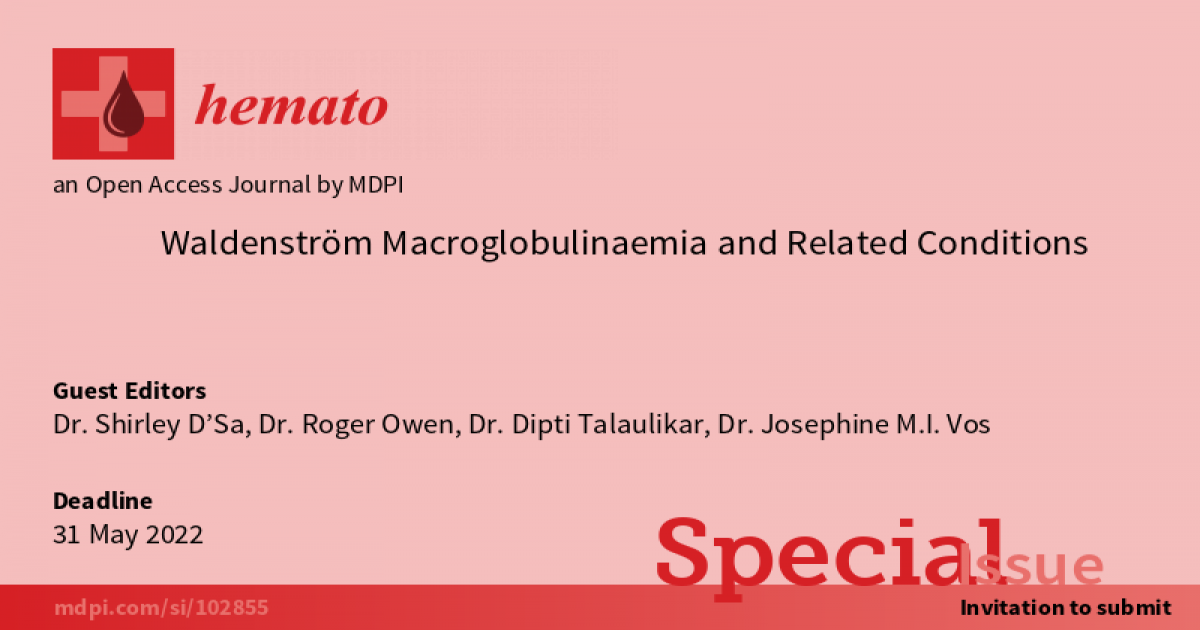- 1.0Impact Factor
- 2.0CiteScore
- 22 daysTime to First Decision
Waldenström Macroglobulinaemia and Related Conditions
This special issue belongs to the section “Plasma Cell Disorders“.
Special Issue Information
Dear Colleagues,
This Special Issue aims to provide a range of important clinical entities that affect patients with Waldenström Macroglobulinaemia (WM) and related conditions. It comes at a time of great change—hot on the heels of enormous biological and clinical developments in the monoclonal IgM field in the past 10 years and tempered by the advent of the COVID-19 global pandemic, which continues to have an impact on clinical practice.
The clinical features of WM and a spectrum of related conditions will be presented. The molecular landscape will be discussed along with its impact on disease behaviour and treatment response. The choice and impact of therapies is particularly important with the option of targeted therapies also available.
Entities of special interest will be discussed, including Bing-Neel syndrome and IgM-related neuropathies, cryoglobulinaemia and IgM-associated AL amyloidosis. The impact of COVID-19 will be addressed and how this influences clinical management of these conditions. Real-world evidence and patient experience are crucial aspects of managing conditions such as WM, which help us shape treatment algorithms. Such information is also highly valued by commissioning bodies as they appraise novel therapies, which are frequently costly, especially given the open-ended and continuous nature of many of these therapies.
Dr. Shirley D’Sa
Dr. Roger Owen
Dr. Dipti Talaulikar
Dr. Josephine M.I. Vos
Guest Editors
Manuscript Submission Information
Manuscripts should be submitted online at www.mdpi.com by registering and logging in to this website. Once you are registered, click here to go to the submission form. Manuscripts can be submitted until the deadline. All submissions that pass pre-check are peer-reviewed. Accepted papers will be published continuously in the journal (as soon as accepted) and will be listed together on the special issue website. Research articles, review articles as well as short communications are invited. For planned papers, a title and short abstract (about 250 words) can be sent to the Editorial Office for assessment.
Submitted manuscripts should not have been published previously, nor be under consideration for publication elsewhere (except conference proceedings papers). All manuscripts are thoroughly refereed through a single-blind peer-review process. A guide for authors and other relevant information for submission of manuscripts is available on the Instructions for Authors page. Hemato is an international peer-reviewed open access quarterly journal published by MDPI.
Please visit the Instructions for Authors page before submitting a manuscript. The Article Processing Charge (APC) for publication in this open access journal is 1200 CHF (Swiss Francs). Submitted papers should be well formatted and use good English. Authors may use MDPI's English editing service prior to publication or during author revisions.
Keywords
- waldenström macroglobulinaemia
- molecular landscape
- immunochemotherapy
- BTK inhibitors and other targeted therapies
- cryoglobulinaemia
- AL amyloidosis
- Bing-Neel syndrome
- IgM-related neuropathies
- patient preferences
- quality of life
- COVID-19

Benefits of Publishing in a Special Issue
- Ease of navigation: Grouping papers by topic helps scholars navigate broad scope journals more efficiently.
- Greater discoverability: Special Issues support the reach and impact of scientific research. Articles in Special Issues are more discoverable and cited more frequently.
- Expansion of research network: Special Issues facilitate connections among authors, fostering scientific collaborations.
- External promotion: Articles in Special Issues are often promoted through the journal's social media, increasing their visibility.
- e-Book format: Special Issues with more than 10 articles can be published as dedicated e-books, ensuring wide and rapid dissemination.

